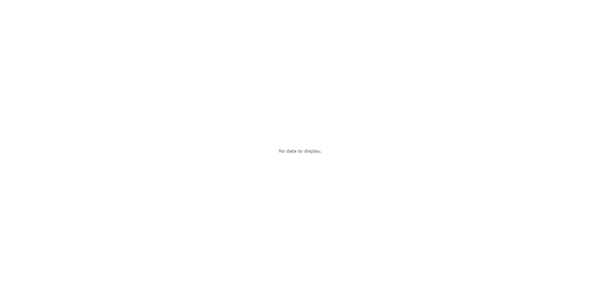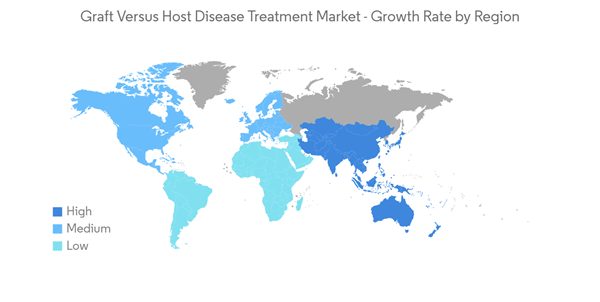The Graft Versus Host disease treatment market is projected to register a CAGR of 8.4% during the forecast period.
The COVID-19 pandemic had a significant impact on the market's growth rate. Graft-versus-Host disease (GvHD) is a condition that occurs in people who have received allogeneic transplantation. The donor immune cells attack the recipient's body organs and cause a 'cytokine storm.' A cytokine storm refers to the overproduction of inflammatory cytokines, which may result in local organ damage. As per a review published in Nature in April 2021, a similar condition occurs during the incidence of COVID-19, where the immune system of the infected individual produces increased levels of inflammatory cytokines, resulting in organ failure. Thus, the severity of the GvHD increases when the patient is affected by COVID-19. The increase in complications posed a serious challenge to the healthcare system globally during the COVID-19 pandemic phase. Thus, there was a surge in demand for Graft-versus-Host disease treatment products to combat the further complications that developed due to COVID-19. In addition, the market growth is stabilizing in the current scenario post-COVID-19 as the worldwide restrictions eased down and disease screening services resumed.
The increasing rate of bone marrow or hematopoietic stem cell treatment, the growing incidence of acute GvHD, and the increasing number of pipeline drugs are likely to propel the market growth throughout the analysis period. For instance, as per a report published by StatPearls Publishing in October 2021, it was found that the incidence of acute GvHD was found to be about 50% for patients receiving HCT from Human Leukocyte Antigen (HLA) matched siblings, and the range was even higher in unmatched donors. The incidence of chronic GvHD was found to be in the range of 6-80%. Additionally, according to an article published by Elsevier in June 2021, in the United States, 42% of the patients had developed cGvHD within three years of allogenic HCT; 66% of those affected by cGvHD were found to have acute GvHD prior. The refractory nature of cGvHD is expected to propel the growth of the GvHD treatment market.
High investments in R&D capabilities by industry players and governments are anticipated to create lucrative opportunities in the market. For instance, in June 2021, Equillium Inc. reported the completion of an End-of-Phase 1 meeting with the US FDA for itolizumab in the first-line treatment of patients with acute graft-versus-host disease (aGvHD). Thus, the positive outcome of such clinical trials will likely lead to new treatments, which will be expected to boost the market's growth over the forecast period.
Thus, owing to the abovementioned factors, the market is anticipated to project growth over the forecast period. However, the high cost of GvHD treatment is expected to limit the growth of the market.
Additionally, according to the Organ Procurement and Transplantation Network of the United States Department of Human Health Services, around 41,355 transplants were performed in the United States in 2021. Since graft-versus-host disease is most commonly associated with and might occur after transplants, the demand for corticosteroids as an introductory therapy is likely to increase among the patient population, ultimately driving the segment growth.
Furthermore, research studies carried out to improve the efficiency of corticosteroids in the treatment are also boosting the growth of the market segment. For instance, as of June 2022, a clinical trial was ongoing. It is an open-label, multicenter, two-arm randomized trial that will evaluate whether the addition of ruxolitinib combined with corticosteroids is superior to corticosteroids alone in newly diagnosed high-risk aGvHD. It was reported that there is about a 50% response rate to first-line therapy with corticosteroids for acute graft-versus-host disease (aGvHD). The positive outcome of such clinical trials can improve efficiency and thus may lead to segmental growth in the future.
Thus, owing to the abovementioned factors, the market segment is expected to project growth over the forecast period.
Furthermore, the approval from the regulatory authority is also contributing to the growth of the region. For instance, in September 2021, the US FDA approved the use of Ruxolitinib for the treatment of chronic graft-versus-host disease after the failure of any two conventional treatments in patients aged 12 years or older. Ruxolitinib is a promising candidate drug since the drug helps to overcome steroid resistance associated with graft-versus-host disease.
Additionally, in July 2021, the US FDA approved Belumosudil for the treatment of chronic graft-versus-host disease. The drug is permissible for patients older than 12 years and older and those who have already attempted two other treatments. Such approvals are bolstering the growth of the market in the region.
Thus, owing to the abovementioned factors, the North American region is expected to show significant growth over the forecast period.
This product will be delivered within 2 business days.
The COVID-19 pandemic had a significant impact on the market's growth rate. Graft-versus-Host disease (GvHD) is a condition that occurs in people who have received allogeneic transplantation. The donor immune cells attack the recipient's body organs and cause a 'cytokine storm.' A cytokine storm refers to the overproduction of inflammatory cytokines, which may result in local organ damage. As per a review published in Nature in April 2021, a similar condition occurs during the incidence of COVID-19, where the immune system of the infected individual produces increased levels of inflammatory cytokines, resulting in organ failure. Thus, the severity of the GvHD increases when the patient is affected by COVID-19. The increase in complications posed a serious challenge to the healthcare system globally during the COVID-19 pandemic phase. Thus, there was a surge in demand for Graft-versus-Host disease treatment products to combat the further complications that developed due to COVID-19. In addition, the market growth is stabilizing in the current scenario post-COVID-19 as the worldwide restrictions eased down and disease screening services resumed.
The increasing rate of bone marrow or hematopoietic stem cell treatment, the growing incidence of acute GvHD, and the increasing number of pipeline drugs are likely to propel the market growth throughout the analysis period. For instance, as per a report published by StatPearls Publishing in October 2021, it was found that the incidence of acute GvHD was found to be about 50% for patients receiving HCT from Human Leukocyte Antigen (HLA) matched siblings, and the range was even higher in unmatched donors. The incidence of chronic GvHD was found to be in the range of 6-80%. Additionally, according to an article published by Elsevier in June 2021, in the United States, 42% of the patients had developed cGvHD within three years of allogenic HCT; 66% of those affected by cGvHD were found to have acute GvHD prior. The refractory nature of cGvHD is expected to propel the growth of the GvHD treatment market.
High investments in R&D capabilities by industry players and governments are anticipated to create lucrative opportunities in the market. For instance, in June 2021, Equillium Inc. reported the completion of an End-of-Phase 1 meeting with the US FDA for itolizumab in the first-line treatment of patients with acute graft-versus-host disease (aGvHD). Thus, the positive outcome of such clinical trials will likely lead to new treatments, which will be expected to boost the market's growth over the forecast period.
Thus, owing to the abovementioned factors, the market is anticipated to project growth over the forecast period. However, the high cost of GvHD treatment is expected to limit the growth of the market.
Graft Versus Host Disease Treatment Market Trends
Corticosteroids Segment Expected to Witness Notable Growth in the Graft-versus-Host disease treatment Market
The corticosteroids segment is expected to grow owing to the growing burden of target disease and increasing research studies. The corticosteroids segment is expected to witness notable growth over the forecast period due to increasing research and development in corticosteroid and corticosteroid combination therapy to treat HCT patients with graft-versus-host disease. Furthermore, according to the article published in July 2021, by the National Library of Medicine, the absence of second-line treatment for patients suffering from steroid-refractory chronic graft-versus-host disease is concerning. It also demonstrates the huge scope of research that helps benefit the expansion of the graft-versus-host disease treatment market.Additionally, according to the Organ Procurement and Transplantation Network of the United States Department of Human Health Services, around 41,355 transplants were performed in the United States in 2021. Since graft-versus-host disease is most commonly associated with and might occur after transplants, the demand for corticosteroids as an introductory therapy is likely to increase among the patient population, ultimately driving the segment growth.
Furthermore, research studies carried out to improve the efficiency of corticosteroids in the treatment are also boosting the growth of the market segment. For instance, as of June 2022, a clinical trial was ongoing. It is an open-label, multicenter, two-arm randomized trial that will evaluate whether the addition of ruxolitinib combined with corticosteroids is superior to corticosteroids alone in newly diagnosed high-risk aGvHD. It was reported that there is about a 50% response rate to first-line therapy with corticosteroids for acute graft-versus-host disease (aGvHD). The positive outcome of such clinical trials can improve efficiency and thus may lead to segmental growth in the future.
Thus, owing to the abovementioned factors, the market segment is expected to project growth over the forecast period.
North America Expected to Hold a Significant Share in the Market and Expected to do the Same in the Forecast Period
The North American region is expected to hold a significant share of the studied market owing to well-developed healthcare infrastructure, increasing research and development, coupled with a growing number of transplants. For instance, according to the data published by the Organ Procurement and Transplantation Network, operated under the United States Department of Health and Human Services, updated in July 2022, the total number of transplants performed in the United States between January 2022 and June 2022 was 20,663. Such an increase in the number of transplant procedures may, in turn, boost the demand for graft-versus-host disease treatment owing to the immune-mediated response between donor and recipient adaptive immunity, thus propelling the market’s growth.Furthermore, the approval from the regulatory authority is also contributing to the growth of the region. For instance, in September 2021, the US FDA approved the use of Ruxolitinib for the treatment of chronic graft-versus-host disease after the failure of any two conventional treatments in patients aged 12 years or older. Ruxolitinib is a promising candidate drug since the drug helps to overcome steroid resistance associated with graft-versus-host disease.
Additionally, in July 2021, the US FDA approved Belumosudil for the treatment of chronic graft-versus-host disease. The drug is permissible for patients older than 12 years and older and those who have already attempted two other treatments. Such approvals are bolstering the growth of the market in the region.
Thus, owing to the abovementioned factors, the North American region is expected to show significant growth over the forecast period.
Graft Versus Host Disease Treatment Market Competitor Analysis
The Graft Versus Host Disease Treatment market is competitive and consists of several major players. In terms of market share, a few of the major players are currently dominating the market. Some of the companies which are currently dominating the market include Pfizer Inc., Abbvie Inc., Sanofi (Kadmon Pharmaceuticals), Sanofi (Genzyme), Incyte Corporation, Bristol Myers Squibb Company, Genentech Inc., and Astellas Pharma US Inc.Additional benefits of purchasing the report:
- The market estimate (ME) sheet in Excel format
- 3 months of analyst support
This product will be delivered within 2 business days.
Table of Contents
1 INTRODUCTION
4 MARKET DYNAMICS
5 MARKET SEGMENTATION (Market Size by Value - USD million)
6 COMPETITIVE LANDSCAPE
Companies Mentioned (Partial List)
A selection of companies mentioned in this report includes, but is not limited to:
- Pfizer Inc.
- Sanofi (Kadmon Pharmaceuticals)
- Astellas Pharma Inc.
- Incyte Corporation
- AbbVie Inc.
- Bristol Myers Squibb Company
- Sanofi (Genzyme)
- F. Hoffmann-La Roche Ltd (Genentech Inc.)
Methodology

LOADING...










